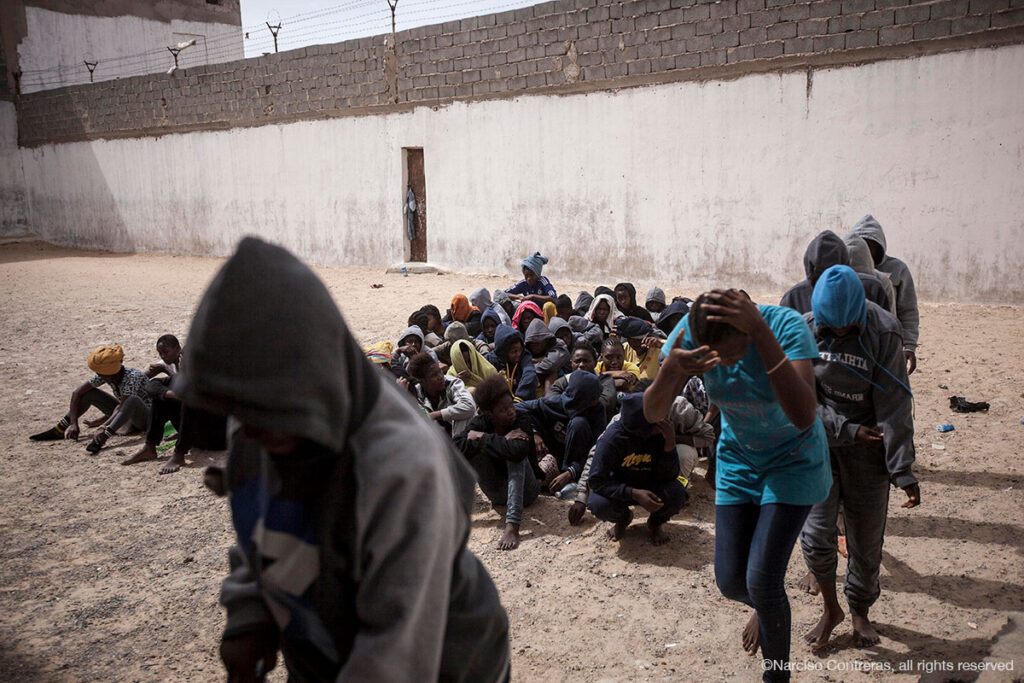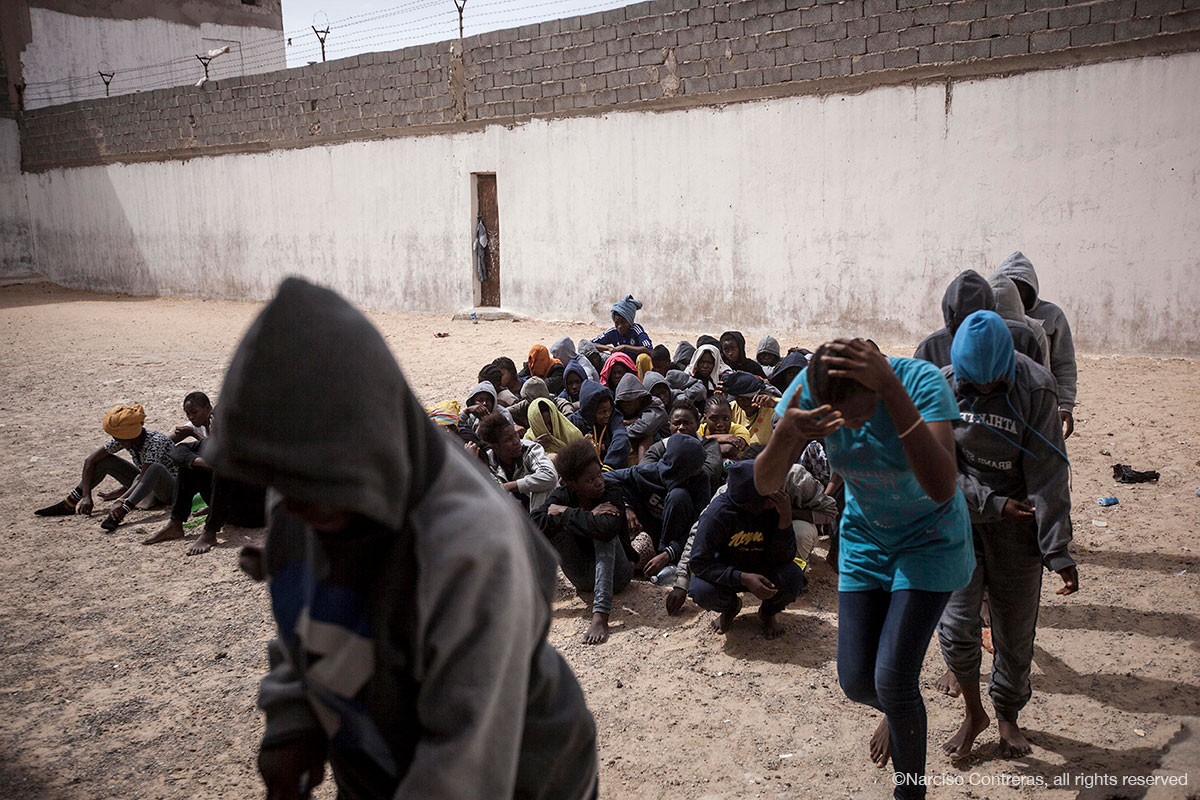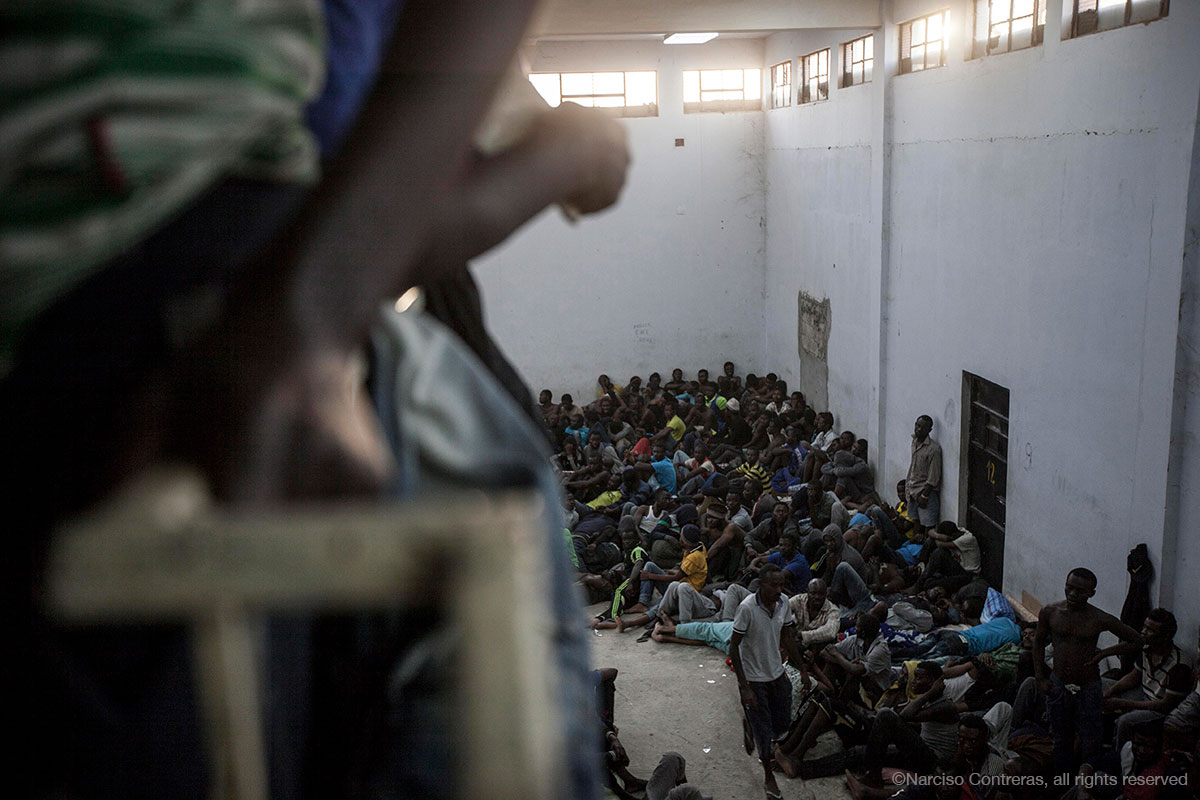Hello and welcome to MOAS…
In this episode we’re looking at human trafficking and the world that surrounds it, both in Libya and Niger. We’ll be drawing perspectives from journalists, academics and international organisations on the ground. But, before we launch into the discussion, let’s break down the differences between human trafficking and smuggling. Both are often used interchangeably but are, in fact, different.
Human trafficking is when people are transported illegally from one country to another under threats or actual force. Victims can end up being used for forced labour or prostitution, for example. With people smuggling, the people involved enter an agreement with a smuggler to make a journey illegally in return for money and are therefore complicit in the movement.
Narciso Contreras is a freelance photojournalist and he’s been investigating Libya’s status as a transit country for migrants. With the help of a network of militias he’s discovered that this label only scratches the surface of the situation on the ground.
We were told from the beginning of the crisis in Libya, even from Gaddafi times, that it was this getaway for migrants attempting to reach Europe by sea. This is partially true and actually the first hypothesis that I worked on this project was based on the official statement of Libya as a transit destination for migrants and migrants that were trapped in the middle of a tribal conflict. So these two lines of this hypothesis were essential to start documenting on the ground this situation. But then the project unfolded.
By the time that I worked in the four months photographing different places in Libya to a different hypothesis by collecting testimonies, doing interviews visiting different especially detention centres, that we realized the real dimension of crisis. So part of what describes the crisis in terms of migration in Libya is that Libya is a transit point destination for a large number of migrants trying to reach Europe by the sea.
But not also it is a transit destination, Libya became a trafficking market where a large number of migrants, not just the ones trying to reach Europe but the ones that go to Libya for working purposes, get trapped in a cycle of trafficking and slavery and it evolves from kidnapping, from extortion, from forced labour and some other different aspects of this situation. We could document both sides of these two aspects of the crisis and this is why by spending enough time we could get a glimpse of the dimension of this crisis but just a glimpse it was not even describe the complexity of this crisis or situation but it just gives a clue about it. We were shocked by doing it, we were shocked by collecting all this information.
You’ve spoken to victims of trafficking. What did they tell you about their experiences?
Back in 2014 I did interviews with migrants in a detention centre in the outskirts of Misrata. They were describing situations; one of them for instance was Eritrean pushing to get to Europe following his wife. At that time he was one among the migrants that told me the militias, the people running the detention centres were asking for ransom to release him. If I remember correctly at that time the amount of money they were asking for him was 300 or 400 euros. Those were the first testimonies at detention centres, and then in the south I met with migrants that were queuing for work at one of these spots on the street in the migrant settlements in the poor neighbourhoods of the outskirts of the city, even in the city centre, where the migrants queue for jobs. Many of these guys were telling me about how different armed groups arrive picking up migrants and taking them to different working locations and forcing them to work without any payment, and not just being forced to work, but also they were subjected to daily beatings and other kind of situations. So since then the first testimonies were pulling me to follow the topic.
But then back in 2016 when we started properly this project I had the chance to interview two migrants that were working for free, one of them for the director of detention centre in Zawiya and the second one was one among three that was working for a militia commander in Sulman. I had the chance to interview them, they were basically working as slaves for these two characters. One of these guys told me from the beginning the story of how he left his home town coming to Libya, going to Libya then paid for a smuggler to take him to Europe. Then when he reached a location in the north a militia group had taken them to another place and they were sold to a third group and this process took over two to three months and then he ended up in a detention centre. After that he found himself working for this militia commander paying for his release for seven months and these were testimonies usually you could find tracking the line of smuggling. Trafficking is more difficult but trafficking actually happens inside detention centres because militias or the groups in charge are the ones by distributing, and also sell the migrants to other groups for ransom purposes.
Can you describe what it was like in the detention centres you visited?
Almost anything you see inside detention centres are horrendous experiences from the overcrowding places, a single room of 10 or 15 square metres or whatever dimension of a room is packed with people. There is no space for anyone to lie on the floor, everyone has to sit in a very small area without the right to stand up. It’s a small place without food, without medication. When I saw the guards, militia guys beating up female migrants who were queuing food because they complained, when they get the chance they complain, they keep complaining all the time and guards try to keep them calm by threatening them or beating them up and I saw this situation and immediately there was a doctor at the place, the doctor screamed to the guards saying that they should stop beating the girl because there were two visitors at the place just to stop doing this.
I think the most shocking was when I met this group of mentally ill female migrants in this former zoo, they were inside cages, former cages of the zoo, completely isolated. They were in the place for years, 2 years at least when I documented one of these women and the living conditions of these mentally ill migrants were terrible. They were sleeping in a very dirty mattress surrounded by excrement, very bad smell and the living conditions for the mentally ill group of female migrants that I met was very, especially since I think they were very representative I think of the worst that being a human being you can face, you can find out in the most difficult situations being a migrant, being ill being an African, being a woman, it’s like being in a position of the most vulnerable. The end of the road. I think when I met this group of women there was nothing else to witness and that was the worst that I could see along the project.
Libya’s illicit economy is well documented and human trafficking and smuggling now make up a key part of it.
It’s a profitable industry allowing groups to stake a claim in post-Gaddafi Libya… Tuesday Reitano is Deputy Director for the Global Initiative. She says that the industry is deeply rooted in Libya’s future. It’s just one of the competing interests ensuring the country remains unstable.
We looked at dynamics both in the North-Western corner which is where the departures have taken place, an over 100 kilometre stretch of the coastline west of Tripoli where 99% of the departures have taken place. But this is really micro politics of Libya and I think even we hadn’t expected how detailed you had to be, how granular in our understanding the dynamics. I mean, our report goes almost city by city, first looking at the dynamics of three or 4 coastal cities and just moving 50 to 100 kilometres south the next hub which is the staging point for the coast and how intertwined the different networks in play are.
We found human smuggling is now probably the second largest economic generator across Libya after fuel smuggling. It is deeply interwoven in to the politics of the competing central states in the east and the west. It is engaging with a number of very traditionally marginalized actors in Libya who are playing their own role in the smuggling industry for political leverage. It took us a while to finish because we found new developments every week, Libya’s politics is volatile and at the same time Libya is part of a broader system across the greater Sahel and horn of Africa.
In post-Gaddafi Libya, human trafficking is the industry that’s helping marginalized and losing groups to get by, but how big was it before the revolution?
Libya and Algeria are the true big hydro carbon economies in Africa and have always drawn migrants to them to work. IOM estimates of migrant stock from Sub-Saharan Africa in the country prior to the revolution was some 600,000 people who were living, working and participating in the Libyan economy perhaps with no greater intention to go onwards from there. But, nonetheless the appeal of the sea route and the call of Europe has been consistent in over decades in Europe. I mean, before Gaddafi’s fall he was negotiating with the Italian government for a 6 billion-euro annual support to prevent the rising rates of irregular migration. So, a lot of people see this is a longstanding and cyclical trend but from our analysis it wasn’t as profitable ever as it is now. A colleague of mine released a report on illicit trafficking in Libya’s transition back in 2013 and that point, migrants were the bottom of the hierarchy, illicit drugs, pharmaceuticals, fuel smuggling, arms smuggling were much higher but I would say that that balance has changed very much now, smuggling has never been so profitable in Libya as it is at the moment.
Any estimates on its current value?
You can estimate, we do in our analysis track the prices that people are paying. What is made that more complicated is that the pricing structure has changed and there are a number of different groups now issuing. Essentially you can do the maths. Back in 2015 we issued an estimate that said it was 323 million dollar industry in Libya in 2015/16. At this point now actually the costs on a boat have fallen but the number of people travelling have increased and there has become a secondary trade building up around extortion of migrants in Libya, and although this also existed it’s growing in its practice. So now I would say that it’s certainly over half a billion.
When you talk about the illicit economy, you say that trafficking is one point of a perverse resource triangle. What is that, what are the other two points and how do they work together?
I think what we were very struck by in our analysis is that in the post-revolutionary period in Libya how the incentive systems were so structured to orientate people towards external interests often which are counter to the consolidation of the central state rather than internal interests, domestic interests among or creating or recreating a coherent single Libyan state. Basically, it’s exactly at the where the post conflict period everybody should be looking toward the one unified Libya, in actual fact there was nothing encouraging that.
So we identified this as the perverse resource triangle and the first in this triangle was almost the most extraordinary in that it was a highly militarized culture there were militia groups who had enormous influence over the political process, and the state was paying those militias because there was no central state security organ by design under the Gaddafi regime; the transitional state was left negotiating with individual militia groups to try and get them to keep the peace. Now essentially the militia groups, the noisier and more violent they were, the more they were paid for peacekeeping so interestingly enough no one, none of these militia groups had any intent of being well behaved and playing the game. It was far better for them to be dissonant and difficult and to try and be bought off. So there I think was certainly, perverse is the word, a perverse incentive in place in the central state process.
The second was that the state was very much underpinned by a set of regional actors. So it’s the classic resource curse in some ways that Libya’s extraordinary oil wealth meant that for a series of actors both in the region and beyond in the Gulf, having Libya’s allegiance was important and it was very much a decision of the trans process sponsored by international actors that they would keep the petroleum dollars flowing to the central state and the distribution, the prerogative of the central state so it set up a ‘winner takes all’ dynamic, the controlling group that managed to secure power in the post trans period essentially controlled in absolute all of Libya’s resources. The oil economy is worth 80% of Libya’s export value and its billions. so we have a series of proxy interests, the Turks, the Russians, and others all in three to make sure that they have some sway over this hydro car giant in the world’s energy economy and there again it was played through military groups who had to prove their ability to influence and they proved their ability to influence by being disruptive, so again we have a second element in the post conflict dynamic where the goal was disruption rather than consolidation.
Then finally we studied in great detail illicit trafficking, and illicit trafficking took a slightly different pattern in that it became the alterative for the groups marginalized from the central state, so whereas a lot of focus was on the coastal economies down in the southern borders groups who had historically always been involved in cross border trade across the Sahara now found illicit trafficking to be a very positive and dynamic resource flow that allowed them to have a valid voice in the transition, again it was by being difficult, by engaging in illicit acts they sought political influence and human smuggling became the top of the pyramid. So we talked earlier about hierarchy of illicit economies, human smuggling became the top of that pyramid by accident this was really a confluence of circumstances where the war in Syria and the growing displacement intersected with a local controlled group in the horn of Africa. So, it’s partly serendipity of the unfortunate nature that illicit trafficking and the movement of human beings became so influential in Libya’s transition.
Is there a way to stop human trafficking or smuggling? Let’s head South West through the perilous Sahara Desert and back to Niger, a hub for departing migrants.
Smuggling and trafficking are huge operations here and according to UNHCR and IOM on the ground, we still don’t know enough about their full impact. What we learn about their activities comes from speaking to its victims. A new appeal has been launched for more time and investment on the ground.
Nagette Belgecem is the Senior Policy Officer for UNHCR.
So in terms of activities there’s a number of them. There’s an opening of an office in Agadez where the UN is already present. There’s an increase of monitors that we plan to dispatch along the main routes and obviously show where possible and also for security concern in Niger making it difficult for us to deploy throughout the country and along the borders. There’s a referral system that we have put in place jointly with IOM and the government which is aimed at assessing what the needs of the people on the move and trigger the required assistance, services that they may need so with a clear definition of roles and responsibilities between IOM and UNHCR. There’s an information campaign that we plan to also have that we will build upon what already exists. There will also be a scale up of potential for solutions because for certain people the option of not moving forward across Libya but then remaining in Niger may not be the best option and for which would be scaling up the scope for resettlement and other types of solutions.
But is it achievable?
One needs to have a comprehensive approach to the problem and please note that Niger is a transit country all the other countries that migrants and refugees on the move are crossing ahead of Niger, Burkina Faso, Mali, Chad. So the comprehensive approach would mean that one needs to have a broader scope of the issue outside of Niger, but then within Niger then broader approach would entail not only development activities but also solutions, life saving and then its commonly said that those that are behind the trafficking rings are making a lot of money out of these racket business.
And maybe if you only approach the issue from a developmental aspect which is required may not be sufficient because if you get so much out of this business then you offer basic livelihood one may not be interested in it and then just continue business as usual, this is one. And then second they also very serious security concerns with regard to Niger and this part of the country that is prone to people smuggling and trafficking that if their business is scared then that may well turn into fully fledged insecurity for part of the country. So it’s very dedicated must be approached from all aspects including security, including in terms right communication with all communities concerned on the ground.
So human trafficking is an endemic problem, a financially lucrative industry grown out of exploitation and force. Libya’s instability makes it a great way to survive and for some ambitious groups, a tool to influence the country’s future.The international community sees this, it recognises Niger as a major funnel to Libya for refugees and migrants from neighbouring states. And their response? ‘We still don’t know enough about the problem’. More developmental assistance and better monitoring is coming but the desired outcome is a long way off.
Next month charts three years since MOAS first took to the seas to save lives.To celebrate, the podcast is talking to fellow civil society organisations. We’ll explore their work with people who experience forced migration and gather up the lessons learned.
Until then you can follow us on our social media. Check out our latest updates on Facebook, Twitter, Instagram, Youtube and AudioBoom… or you can support our rescue missions by giving whatever you can to help us save lives at sea. Don’t forget to like, comment and subscribe for more podcasts from us.
This project has been funded with support from the European Commission. This publ ication reflects the views only of the author, and the Commission cannot be held responsible for any use which may be made of the information contained therein.
ication reflects the views only of the author, and the Commission cannot be held responsible for any use which may be made of the information contained therein.



